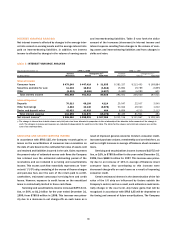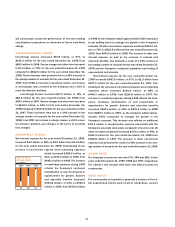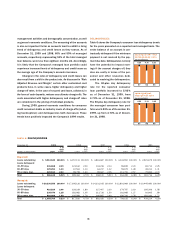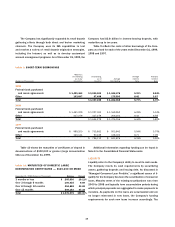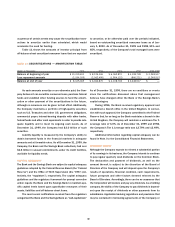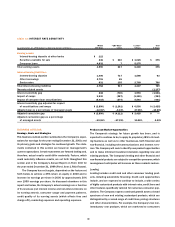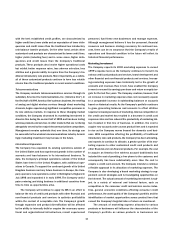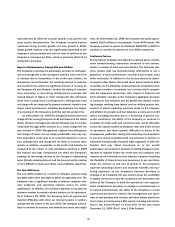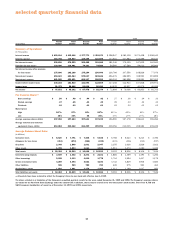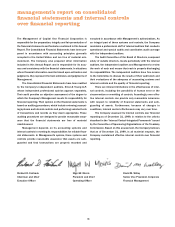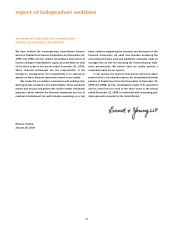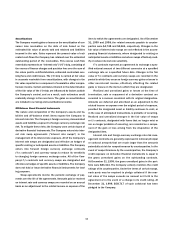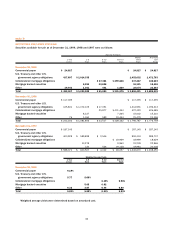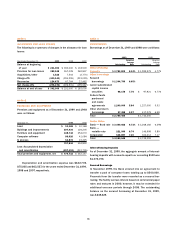Capital One 1999 Annual Report Download - page 45
Download and view the complete annual report
Please find page 45 of the 1999 Capital One annual report below. You can navigate through the pages in the report by either clicking on the pages listed below, or by using the keyword search tool below to find specific information within the annual report.
44
characterized by different account growth, loan growth and
asset quality characteristics. The Company currently expects
continued strong account growth and loan growth in 2000.
Actual growth, however, may vary significantly depending on the
Company’s actual product mix and the level of attrition on the
Company’s managed portfolio, which is primarily affected by
competitive pressures.
Impact of Delinquencies, Charge-Offs and Attrition
The Company’s earnings are particularly sensitive to delinquen-
cies and charge-offs on the Company’s portfolio and to the level
of attrition due to competition in the credit card industry. As
delinquency levels fluctuate, the resulting amount of past-due
and overlimit fees, which are significant sources of revenue for
the Company, will also fluctuate. Further, the timing of revenues
from increasing or decreasing delinquencies precedes the
related impact of higher or lower charge-offs that ultimately
result from varying levels of delinquencies. Delinquencies and
net charge-offs are impacted by general economic trends in con-
sumer credit performance, including bankruptcies, the degree
of seasoning of the Company’s portfolio and the product mix.
As of December 31, 1999, the Company had the lowest net
charge-off rate among the top ten credit card issuers in the United
States. However, management expects delinquencies to increase
moderately through 2000 and that, as a result, charge-offs will
also increase in 2000. Management cautions that delinquency
and charge-off levels are not always predictable and may vary
from projections. In the case of an economic downturn or reces-
sion, delinquencies and charge-offs are likely to increase more
quickly. In addition, competition in the credit card industry, as
measured by the volume of mail solicitations, declined in 1999
but remains very high. Competition can affect the Company’s
earnings by increasing attrition of the Company’s outstanding
loans (thereby reducing interest and fee income) and by making
it more difficult to retain and attract more profitable customers.
The Year 2000 Issue
The year 2000 problem is a result of computer systems using
two digits rather than four digits to define an applicable year. The
Company uses a significant number of internal computer soft-
ware programs and operating systems across its entire
organization. In addition, the Company depends on its external
business vendors to provide external services for its operations.
As of February 29, 2000, the Company had not experienced
material difficulties with either our internal systems or vendors
arising from the advent of the year 2000. The Company will con-
tinue to monitor its systems and address any issues that might
arise. As of December 31, 1999, the Company had spent approx-
imately $14.5 million for remediation of year 2000 issues. The
Company expects to spend an additional $500,000 in 2000 to
continue to monitor its systems for year 2000 compliance.
Cautionary Factors
The Company’s strategies and objectives outlined above, and the
other forward-looking statements contained in this section,
involve a number of risks and uncertainties. The Company cau-
tions readers that any forward-looking information is not a
guarantee of future performance and that actual results could
differ materially. In addition to the factors discussed above,
among the other factors that could cause actual results to differ
materially are the following: continued intense competition from
numerous providers of products and services which compete
with the Company’s businesses; with respect to financial and
other products, changes in the Company’s aggregate accounts
or consumer loan balances and the growth rate thereof, includ-
ing changes resulting from factors such as shifting product mix,
amount of actual marketing expenses made by the Company
and attrition of accounts and loan balances; an increase in credit
losses (including increases due to a worsening of general eco-
nomic conditions); the ability of the Company to continue to
securitize its credit cards and consumer loans and to otherwise
access the capital markets at attractive rates and terms to fund
its operations and future growth; difficulties or delays in the
development, production, testing and marketing of new products
or services; losses associated with new products or services or
expansion internationally; financial, legal, regulatory or other dif-
ficulties that may affect investment in, or the overall
performance of, a product or business, including changes in exist-
ing laws to regulate further the credit card and consumer loan
industry and the financial services industry, in general (including
the flexibility of financial services companies to use and share
data); the amount of, and rate of growth in, the Company’s
expenses (including salaries and associate benefits and mar-
keting expenses) as the Company’s business develops or
changes or as it expands into new market areas; the availability
of capital necessary to fund the Company’s new businesses; the
ability of the Company to build the operational and organiza-
tional infrastructure necessary to engage in new businesses or
to expand internationally; the ability of the Company to recruit
experienced personnel to assist in the management and opera-
tions of new products and services; and other factors listed from
time to time in the Company’s SEC reports, including, but not lim-
ited to, the Annual Report on Form 10-K for the year ended
December 31, 1999 (Part I, Item 1, Risk Factors).


